Introduction
Recently, three major parallel EVM projects have launched their testnets simultaneously: Monad launched its testnet on February 19, MegaETH on March 21, and Pharos on March 24. The main narrative of Web3 technology seems to have returned to parallel EVM after the AI Agent, which is the hottest narrative at the beginning of 2024.

EVM (Ethereum Virtual Machine) is the core of Ethereum, responsible for running smart contracts and processing transactions. EVM is a computing engine that provides an abstraction for computation and storage, but it lacks scheduling capabilities. Ethereum's execution module extracts transactions from blocks and the EVM is responsible for executing them sequentially. While sequential execution ensures that transactions and smart contracts can be executed in a deterministic order, ensuring security, it can lead to network congestion and delays under high load conditions.
Parallel EVM significantly increases network throughput by allowing multiple operations to be executed simultaneously, thereby enhancing the overall performance and scalability of the blockchain. In fact, what we refer to as parallel EVM actually means high-performance EVM-compatible blockchains that not only introduce parallel execution but also undergo comprehensive upgrades from consensus, transactions, pipelining, storage to hardware acceleration. The goal is to enable blockchain networks to process more transactions in a shorter time, effectively addressing the network congestion and delay issues of traditional blockchains.
This article will delve into the background and architecture of the three projects: Monad, MegaETH, and Pharos, as well as the trade-offs developers face in their choices.
Monad
Monad is a high-performance EVM-compatible Layer 1 blockchain developed by Monad Labs. Monad improves system scalability while maintaining decentralization, addressing the low throughput issues of existing EVM-compatible blockchains.
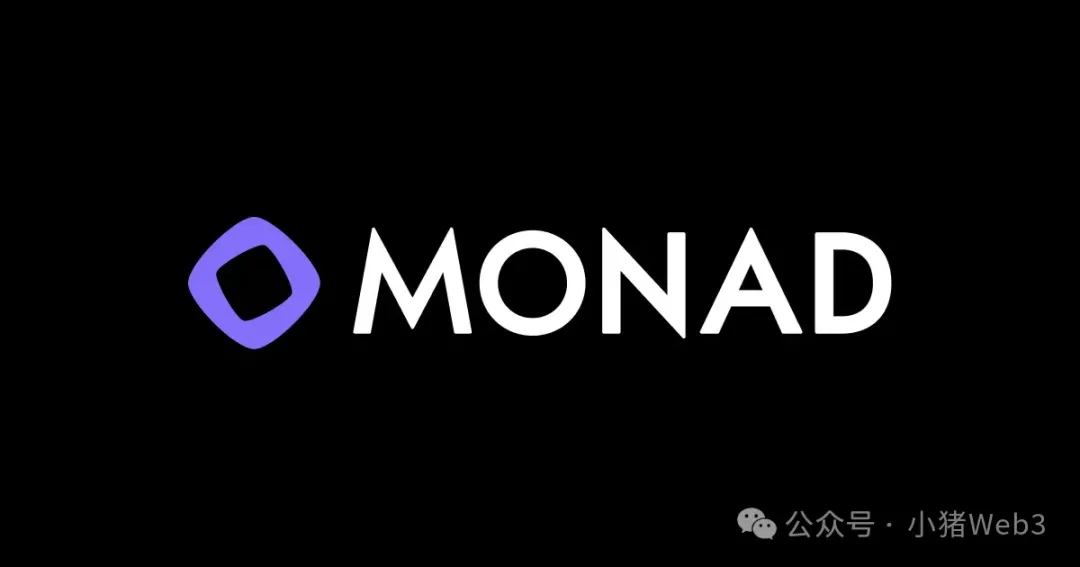
Monad Labs was co-founded in 2022 by Keone Hon, James Hunsaker, and Eunice Giarta, with Keone and James being former employees of the market-making giant Jump Trading, and Eunice coming from a non-Crypto background.
In February 2023, Monad Labs completed a seed round of $19 million in funding, led by Dragonfly; in April 2024, Monad Labs completed a new round of $225 million in funding, led by Paradigm. Monad is currently valued at $3 billion.
Monad's key advantage lies in its ability to handle up to 10,000 transactions per second with a block time of 1 second. This is primarily due to optimizations in the following four areas:
MonadBFT: A high-performance consensus mechanism based on an improved version of HotStuff. It is used to achieve consensus on transaction ordering under partially synchronous conditions in the presence of Byzantine actors. First, MonadBFT employs a two-phase BFT algorithm that has optimistic responsiveness and linear communication overhead in common cases, with quadratic communication overhead in timeout cases. Second, MonadBFT uses a hybrid signature scheme, where the integrity and authenticity of messages are provided by ECDSA signatures, while aggregable message types (votes and timeouts) are provided by BLS signatures, addressing scalability issues. Additionally, in Monad, nodes do not maintain a global transaction pool but rather a local transaction pool, with transactions being forwarded by RPC nodes to subsequent leader nodes, effectively reducing bandwidth usage and transaction delays. Finally, MonadBFT's message propagation also utilizes the RaptorCast protocol, which not only converts block proposals into erasure-coded blocks but also sends each block to all validators via a two-level broadcast tree. RaptorCast leverages the entire network's upload bandwidth to disseminate block proposals to all validators while retaining Byzantine fault tolerance. Due to these features, MonadBFT can achieve efficient and robust blockchain consensus;
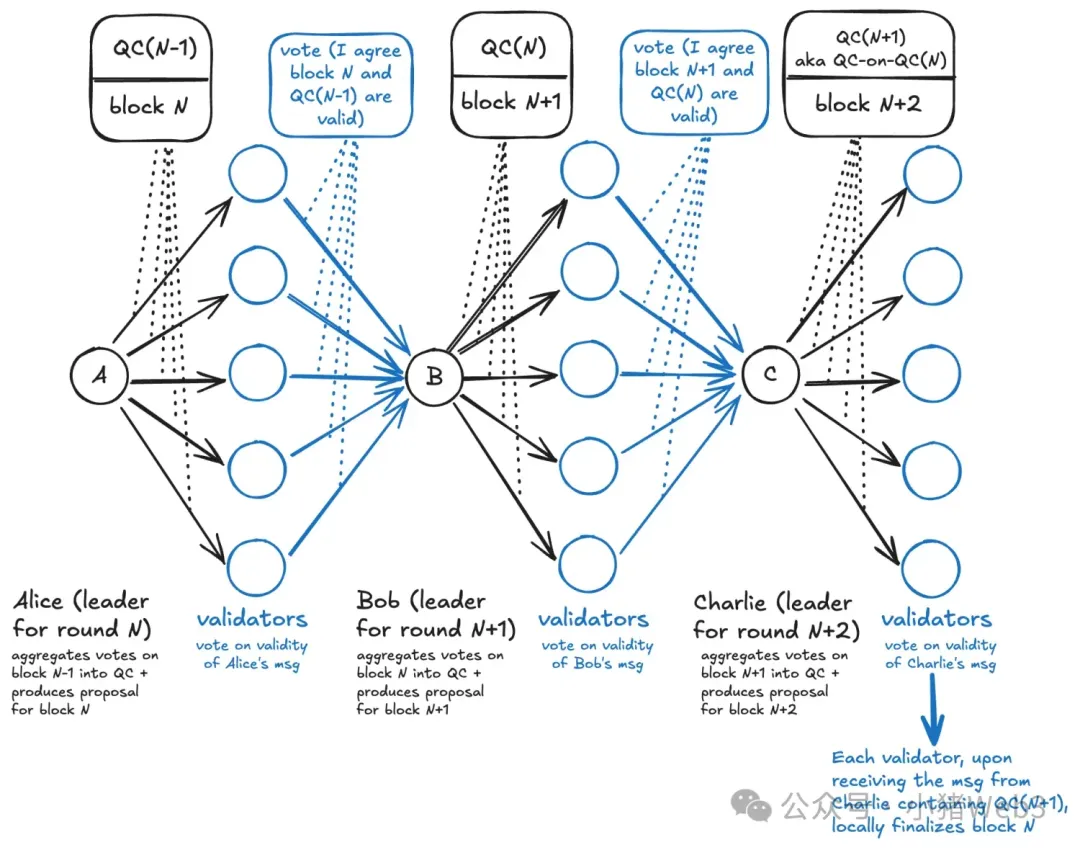
Asynchronous Execution: Asynchronous execution allows Monad to significantly increase execution throughput by separating consensus from execution. By decoupling consensus from execution, Monad can greatly increase the execution budget, as execution shifts from occupying a small portion of block time to occupying the entire block time. First, Monad block proposals do not include the state root; to prevent node forks, block proposals also include the state root from three blocks prior, allowing nodes to detect if they have forked. Second, leader nodes construct blocks from a delayed state perspective; to defend against DDoS attacks, Monad nodes verify that the account's balance is sufficient to cover the highest debit in the user account related to ongoing transactions. Finally, when nodes receive proposed blocks, although the blocks are not yet finalized, they can still execute the proposed blocks locally during this period, but there is no guarantee that they will be voted on or finalized. These characteristics allow Monad to achieve significant speed improvements, enabling a single-shard blockchain to scale to millions of users;
Parallel Execution: Monad employs an optimistic execution approach, starting to execute subsequent transactions before earlier transactions in the block are completed, with the updated state of each transaction being merged in order. This can sometimes lead to incorrect execution results. To address this, Monad tracks the inputs used during transaction execution and compares them with the outputs of previous transactions. If discrepancies exist, it indicates that the transaction needs to be re-executed with the correct data. Additionally, Monad uses a static code analyzer during transaction execution to predict dependencies between transactions to avoid invalid parallel execution. In the best case, Monad can predict many dependencies in advance; in the worst case, it falls back to a simple execution mode. Monad's parallel execution technology not only improves network efficiency and throughput but also reduces transaction failures caused by parallel execution through optimized execution strategies;
MonadDB: MonadDB is a key component of Monad that maintains full compatibility with Ethereum while providing high performance. MonadDB is a custom KV database designed to store verified blockchain data. First, MonadDB natively implements the Merkle Patricia Trie data structure in both disk and memory and has its own indexing system, eliminating file system dependencies, thus efficiently storing Merkle Patricia Trie nodes on disk. Second, MonadDB employs asynchronous I/O, fully leveraging the latest kernel support for asynchronous I/O, avoiding the generation of numerous kernel threads to handle pending I/O requests in an attempt to execute work asynchronously. Finally, MonadDB also utilizes techniques such as concurrency control, sequential writes, and data compression to further optimize its performance. Due to these features, MonadDB reduces data access time and increases transaction processing speed, thereby enhancing the overall performance of the blockchain network.
MegaETH
MegaETH is currently the fastest Layer 2 blockchain, developed by MegaLabs. What sets MegaETH apart is its focus on real-time blockchain performance, providing ultra-low latency and scalability for applications that require instant responsiveness.
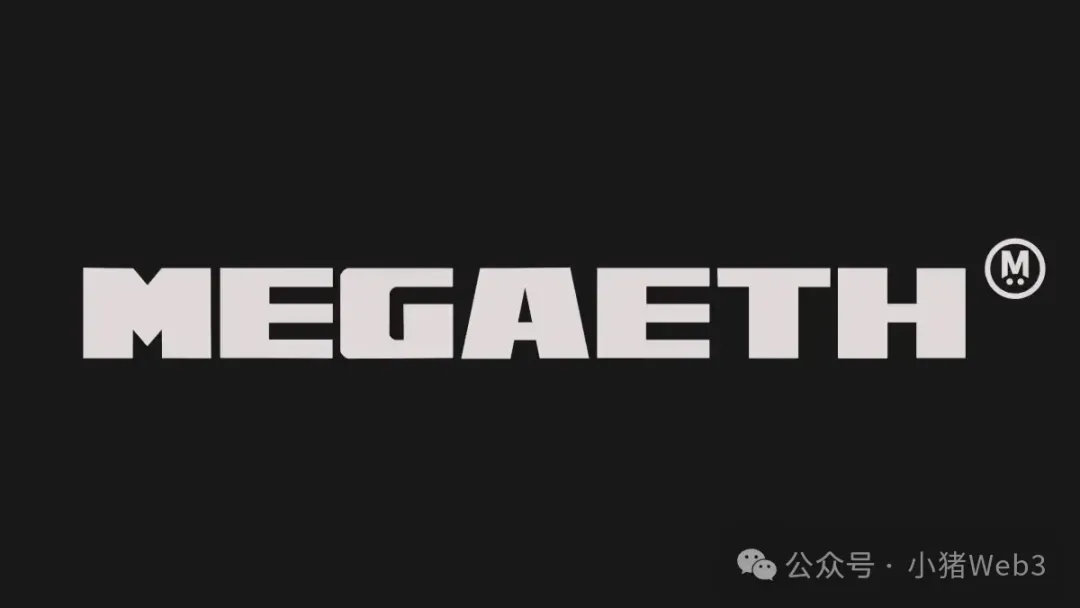
MegaLabs was founded in early 2023, with CEO Li Yilong holding a PhD in Computer Science from Stanford University and having previously worked at the software company Runtime Verification Inc.; CTO Yang Lei is a PhD from MIT; CBO Kong Shuyao was the former global business development director at Consensys; and growth director Namik Muduroglu has worked at Consensys and Hypersphere.
In June 2024, MegaLabs completed a seed round of $20 million in funding, led by Dragonfly; in December 2024, MegaLabs completed a community round of funding on the Echo platform, reaching its $10 million funding goal in just 3 minutes. MegaETH is currently valued at over $200 million.
MegaETH boasts 100k TPS and approximately 10ms block time, achieving millisecond-level response times even under high load. This is primarily due to the following technical features:
Node Specialization: MegaETH has different types of nodes that perform different functions, requiring different hardware configurations. In MegaETH, there are three roles: the Sequencer is responsible for transaction ordering and execution, with only one centralized node, eliminating the overhead of consensus. The Sequencer publishes the generated blocks, witness data, and state differences to EigenDA (data availability layer), ensuring that this data is available in the network; Provers obtain blocks and witness data from the Sequencer and perform stateless verification using dedicated hardware, allowing them to asynchronously and unordered verify blocks without storing the entire blockchain state; Full nodes receive state differences from the Sequencer, update their local state, and can verify the validity of blocks through the proof network, ensuring the consistency and security of the blockchain;
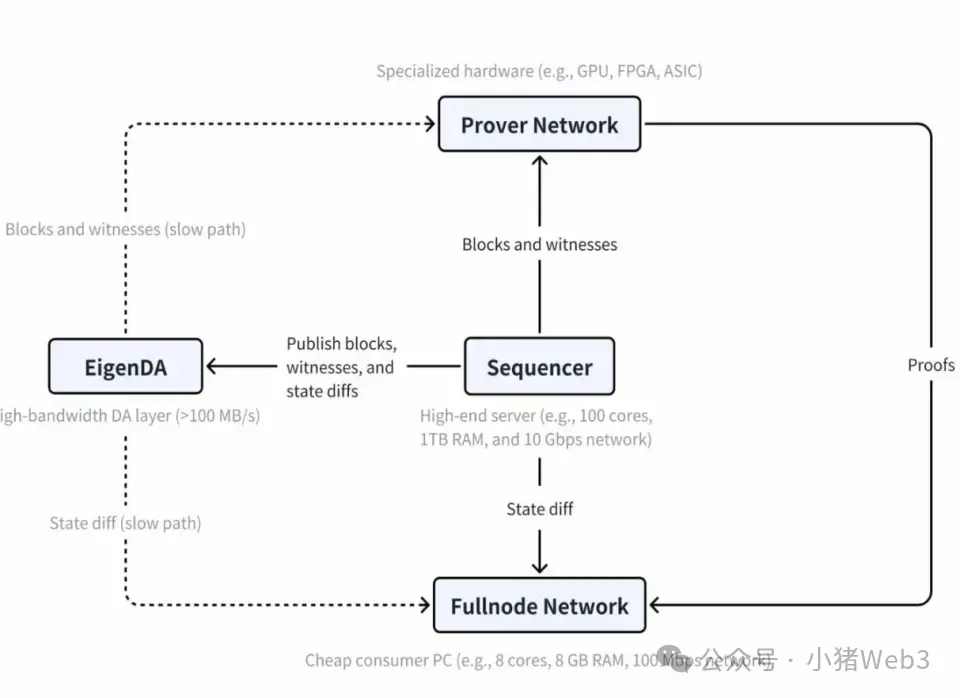
Targeted Optimization: MegaETH addresses various issues faced by traditional EVM blockchains with targeted solutions. To tackle the problem of high latency in state data retrieval, MegaETH has designed a new state Trie that is highly efficient in memory and I/O, capable of smoothly scaling to several TB of state data without incurring additional I/O costs; to address the issue of serial execution, the Sequencer in MegaETH can adopt any parallel execution strategy; to improve interpreter efficiency, MegaETH uses a JIT compiler to eliminate interpretation overhead, providing near bare-metal performance for compute-intensive DApps; to reduce excessive bandwidth for state synchronization, MegaETH has designed an efficient state difference encoding and transmission method that can synchronize a large number of state updates under limited bandwidth, while also employing advanced compression techniques to synchronize complex transaction state updates within bandwidth constraints;
Mini Blocks: MegaETH performs a pre-confirmation every 10 milliseconds, referred to as Mini Blocks. The headers of standard EVM Blocks occupy a significant amount of space (500+ bytes), and the computation of three Merkle Roots is also quite time-consuming, making the use of standard EVM Blocks a substantial burden for light clients. MegaETH's Mini Blocks are generated in parallel with EVM Blocks and provide the same inclusion guarantees, but significantly shorten the interval for propagation to the rest of the network. Light clients use MegaETH's unique Realtime API to access transactions that are in Mini Blocks but not yet in EVM Blocks.

Pharos
Pharos is positioned as a high-performance EVM-compatible Layer 1 blockchain, dedicated to creating the best RWA and Payment ecosystem. Pharos boasts an ultra-high performance of processing 50,000 transactions per second and consuming 2 billion gas units (2 gigagas) per second.

Founded in 2024, CEO Alex Zhang previously served as the CTO of AntChain and later became the CEO of AntChain's Web3 brand ZAN; CTO Wishlonger was the former CSO of AntChain; CMO Laura was responsible for marketing at Solana Labs, successfully selling out the first generation of Solana phones, Saga; COO Sally worked at OKX; CCO Matthew led ecosystem development and business growth at Stellar and Ripple.
In November 2024, Pharos completed a seed round of $8 million in funding, led by Lightspeed Faction and Hack VC.
Pharos proposed the "Degree of Parallelization (DP)" framework, which categorizes the parallelization capabilities of blockchains into six levels (DP0-DP5), with Ethereum being DP0, having no parallelization at all. From DP1 to DP5, improvements include enhanced consensus mechanisms, parallel transactions, pipelining, parallel Merkleization, and accelerated state access and parallel heterogeneous computing.
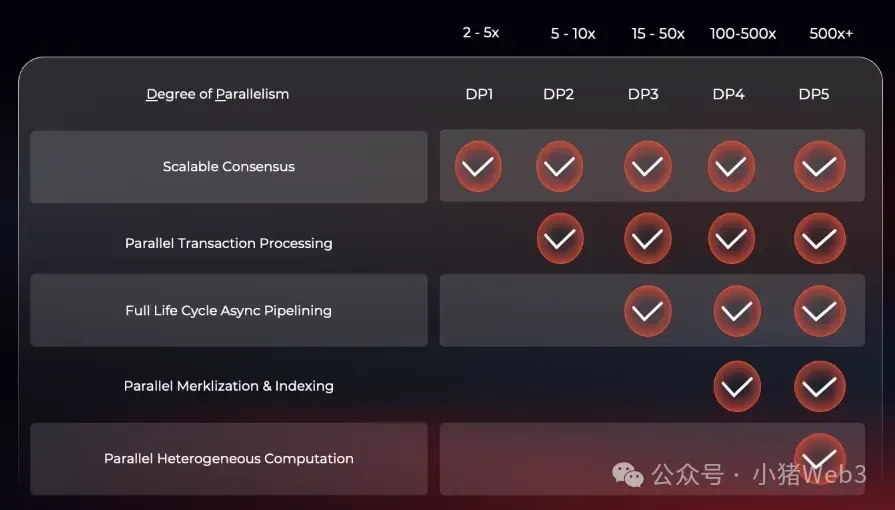
Pharos adopts a DP5 full-stack parallel architecture, with comprehensive upgrades from consensus, transactions, pipelining, storage to hardware acceleration:
Scalable Consensus Protocol: A high-throughput, low-latency BFT consensus protocol that fully utilizes the resources of the entire network;
Dual Virtual Machine Parallel Execution: A parallel execution layer for EVM and WASM, utilizing advanced compilation techniques;
Full Lifecycle Asynchronous Pipelining: Achieving parallel and asynchronous processing throughout the entire lifecycle of each transaction and between blocks;
High-Performance Storage with Authentic Data Structures (ADS): Providing exceptional throughput, low-latency I/O, and cost-effective state storage, securely scaling to billions of accounts;
Modular Special Processing Network (SPN): Seamlessly integrating new software, hardware, and geographic decentralization, supporting various use cases and emerging technologies.
Conclusion
Thanks to Ethereum's long-standing and thorough user education, EVM has the most developers and the largest DApp ecosystem in the Web3 world, almost becoming a presence similar to Javascript in the Web2 world. However, Ethereum's scalability issues severely hinder the further development of EVM, making parallel EVM one of the most important technological directions.
Monad strikes a balance between scalability and decentralization through its parallel execution model, providing developers with a throughput of 10,000 TPS without compromising EVM compatibility. Its independent consensus offers autonomy but sacrifices Ethereum's security guarantees, which may deter developers who prioritize trust and shared security.
MegaETH is undoubtedly the best in terms of latency and throughput (TPS), with ultra-low latency of 10 milliseconds and a throughput of 100,000 TPS, suitable for applications that require near-instantaneous responses, such as GameFi, SocialFi, and high-frequency trading scenarios. However, its centralized Sequencer design may raise concerns about decentralization.
Pharos boasts a transaction processing capability of up to 50K TPS and 2 gGas/s, performing on par with emerging high-performance EVM blockchains like Monad and MegaETH. Additionally, Pharos's "Ant Gene" focuses on institutional clients and compliance requirements for RWA-Fi, genuinely meeting the future market's demand for compliant and efficient blockchain infrastructure.
From the publicly available data, MegaETH and Pharos outperform Monad significantly in terms of performance. However, considering that Monad has the largest funding and ample development resources for breakthroughs, the competition among Monad, MegaETH, and Pharos essentially has no absolute leader, leaving developers with more trade-offs regarding the priorities of performance, decentralization, or specialization.
免责声明:本文章仅代表作者个人观点,不代表本平台的立场和观点。本文章仅供信息分享,不构成对任何人的任何投资建议。用户与作者之间的任何争议,与本平台无关。如网页中刊载的文章或图片涉及侵权,请提供相关的权利证明和身份证明发送邮件到support@aicoin.com,本平台相关工作人员将会进行核查。




